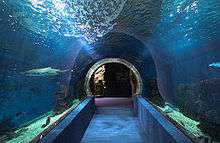Nyíregyháza
Nyíregyháza (Hungarian: [ˈɲiːrɛɟhaːzɒ] (![]()
Nyíregyháza | |
|---|---|
City with county rights | |
| Nyíregyháza Megyei Jogú Város | |
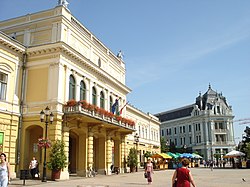 Main square | |
 Flag 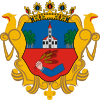 Coat of arms | |
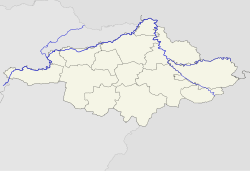 Nyíregyháza 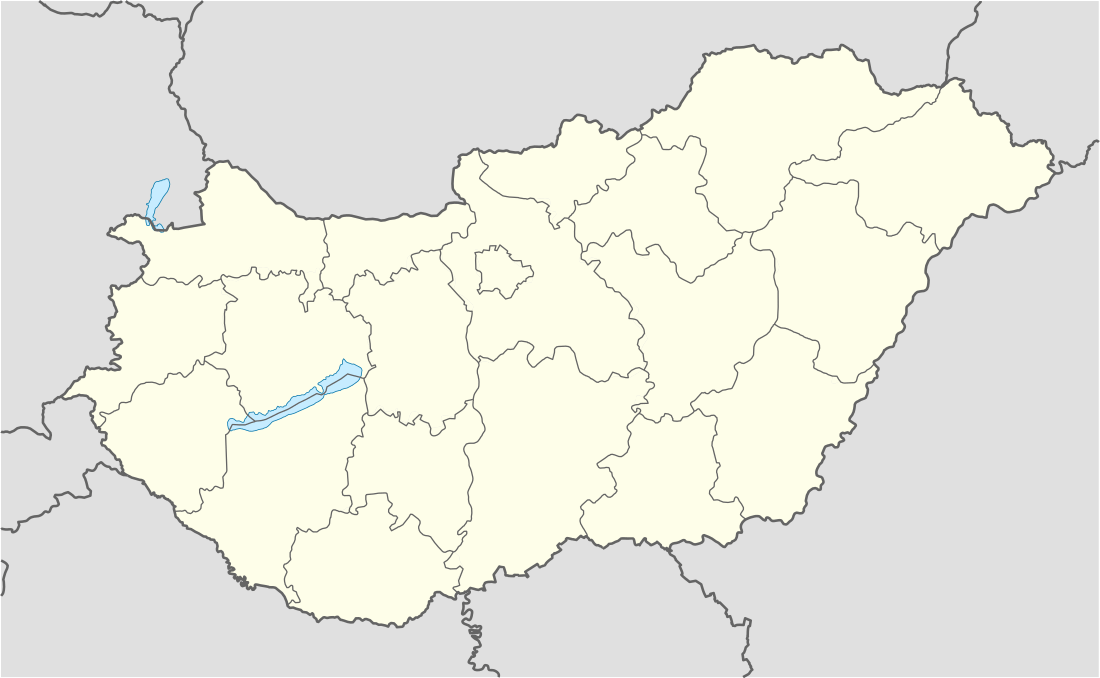 Nyíregyháza  Nyíregyháza | |
| Coordinates: 47.95306°N 21.72713°E | |
| Country | |
| Region | Northern Great Plain |
| County | Szabolcs-Szatmár-Bereg |
| District | Nyíregyháza |
| Established | 9th century AD |
| Market town | 1786 |
| Government | |
| • Mayor | Dr Ferenc Kovács (Fidesz) |
| • Deputy Mayor | Menyhért Jászai (Fidesz-KDNP) Dr Attila Ulrich (Fidesz-KDNP) |
| • Town Notary | Dr Sándor Szemán |
| Area | |
| • City with county rights | 274.46 km2 (105.97 sq mi) |
| Elevation | 116 m (381 ft) |
| Population (2017) | |
| • City with county rights | 117,689[1] |
| • Rank | 7th in Hungary |
| • Density | 425.92/km2 (1,103.1/sq mi) |
| • Urban | 238,020 (3rd)[2] |
| Population by ethnicity | |
| • Hungarians | 86.1% |
| • Gypsies | 1.8% |
| • Germans | 0.5% |
| • Ukrainians | 0.4% |
| • Romanians | 0.3% |
| • Slovaks | 0.2% |
| • Rusyns | 0.1% |
| • Bulgarians | 0.1% |
| • Poles | 0.1% |
| Population by religion | |
| • Roman Catholic | 21.0% |
| • Greek Catholic | 10.6% |
| • Calvinists | 16.4% |
| • Lutherans | 7.0% |
| • Jews | 0.1% |
| • Other | 1.8% |
| • Non-religious | 14.6% |
| • Unknown | 28.5% |
| Time zone | UTC+1 (CET) |
| • Summer (DST) | UTC+2 (CEST) |
| Postal code | 4400 to 4433 |
| Area code | (+36) 42 |
| Motorways | M3 Motorway |
| NUTS 3 code | HU323 |
| Distance from Budapest | 233 km (145 mi) East |
| Airport | Nyíregyháza |
| MP | Tünde Szabó (Fidesz) Győző Vinnai (Fidesz) |
| Website | varoshaza |
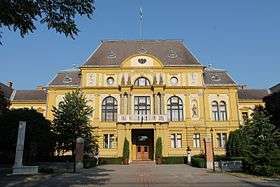
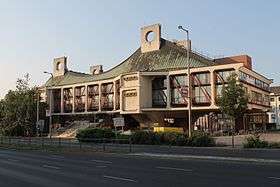
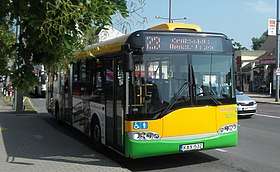
Geography
Nyíregyháza is located in Szabolcs-Szatmár-Bereg County in the northern Plain region (Szabolcs-Szatmár-Bereg county, Hajdú-Bihar county, and Jász-Nagykun-Szolnok County). It is the most important city of Northern Hungary, in all respects the center of the region. It is located in the center of Nyírség as an agricultural town. The boundaries of the city are often understood as a very broad frame, because generally the near suburbs are included in them. It is located at the intersections of routes 4, 41, 36, and 38, therefore the city is easy to reach by road. Sub-Carpathia and Transylvania cannot be reached without passing the city.
History
The first written mentions of Nyíregyháza date back to 1209, although it was then called simply Nyír ('birch'), after the Nyírség, the greater region in which the city lies. A source from 1326 mentions that by then the city already had a church, hence the second part of the name, egyház (meaning 'church'). In the middle of the 15th century the town had about 400 inhabitants. In the 16th century, during the Turkish occupation of Hungary, Nyíregyháza became deserted; it was resettled only in the 1630s – 1640s.
After the War for Independence led by Prince Francis II Rákóczi, the population of the town increased. Most of the new settlers were Slovaks from the area of Békéscsaba. In 1786, Nyíregyháza was granted the right to hold four market days a year; by this time the town was the biggest town of the county with 7,500 inhabitants. In the early 19th century, Nyíregyháza was wealthy enough to become free from its feudal lords, the Dessewffy and Károlyi families. During these prosperous years, the town got a new town hall, a hospital, several schools, and a restaurant by the nearby lake Sóstó ("Salty Lake").
The inhabitants of the town took an active part in the revolution and war for independence in 1848-49, and after the suppression of the revolution several citizens were imprisoned, among them the mayor, Márton Hatzel.
In the second half of the 19th century, Nyíregyháza became more and more urbanized and in 1876 the town became the county seat of Szabolcs County (which is now part of the larger integrated county Szabolcs-Szatmár-Bereg). In 1858, the railroad line reached Nyíregyháza; several new buildings were built, including a telegraph office, the main post office, and the theater. In 1911, the construction of tramways was finished.
After the many trials and tribulations of World War I, Nyíregyháza was under Romanian occupation for ten months. Between the two world wars, the city celebrated the 100th anniversary of becoming free from its feudal landowners.
During World War II, Jews are used as forced laborers by Hungarians. After the German invasion, more than 6,000 of the city's Jewish inhabitants were deported to Auschwitz concentration camp.[5][6] After the war, 2,000 citizens were sent to Russian labor camps (colloquially called malenky robot). Several buildings were destroyed, too, including the Status Quo Synagogue, whose front wall has been preserved; it is now in Nyíregyháza's Jewish Cemetery.[7]
A monument in the memory of the holocaust victims was constructed in 2004.[6]
From the 1960s, the city grew and developed quickly. Today, Nyíregyháza is one of the most prosperous cities of Hungary, being both an educational center and a popular tourist destination.
Nyíregyháza is the birthplace of Israeli artist Zeev Kun who was born here in 1930.
Population
With a population of 118,000, it is the seventh-largest city in Hungary.
| Year | Pop. | ±% |
|---|---|---|
| 1870 | 13,015 | — |
| 1890 | 18,996 | +46.0% |
| 1900 | 28,073 | +47.8% |
| 1910 | 33,444 | +19.1% |
| 1920 | 38,751 | +15.9% |
| 1930 | 46,522 | +20.1% |
| 1941 | 53,917 | +15.9% |
| 1949 | 48,382 | −10.3% |
| 1960 | 56,834 | +17.5% |
| 1970 | 75,245 | +32.4% |
| 1980 | 108,235 | +43.8% |
| 1990 | 114,152 | +5.5% |
| 2001 | 118,795 | +4.1% |
| 2011 | 119,746 | +0.8% |
| 2019 | 116,799 | −2.5% |
| Significant minority groups | |
| Nationality | Population (2011) |
|---|---|
| 613 | |
| 465 | |
| 337 | |
| 305 | |
| 214 | |
Economy
After the change of regime, several foreign-owned companies appeared in the city. In the early 2000s, the largest employers were Hübner Flextronics Ltd. and Hirsch's, but during the period of economic recession, many companies eliminated several thousand jobs. Today, the largest public companies are the Lego Manufacturing Kft. and the Michelin Hungaria Abroncsgyártó Kft., providing employment for about 3000 people.
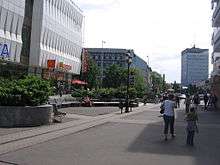
Religions, churches
- Roman Catholic: At the 2011 census, 25,132 people, 20.1% of the population identified themselves as belonging to a particular religion (8365 fewer than in the previous census of 2001). The city is a co-headquarter of the Diocese of Debrecen-Nyíregyháza. The church maintains St. Emeric Catholic High School, Primary School and College and a kindergarten in the city.
- Greek Catholic: At the 2001 census, 12,742 people, 10.6% of the population identified themselves as belonging to a particular religion (6303 less than in 2001). The city is the seat of the only Hungarian Greek Catholic bishopric, the Diocese of Hajdúdorog. The Co-Cathedral of the Nyíregyháza St. Nicholas Bishop Greek Catholic Church, other churches in the city: Jósaváros Greek Catholic Church, Nyíregyháza-Örökösföld Holy Trinity Greek Catholic Church, Nyíregyháza-Borbánya Mother of God church leadership, Fox Mountain St Stephen's Chapel (Sóstóhegy) Nyírszőlős Mother of God birth of the Greek Catholic Church, Nyíregyháza-Oros Protection of the Theotokos Greek Catholic Church, Rozsrétszőlősi Greek Catholic chapel. Here you will find the country's only Greek Catholic institution of higher learning, the St. Athanasius Greek Catholic Theological College. Other religious educational institutions: St. Nicholas Greek Catholic Kindergarten, Primary and Secondary School, Nicholas Soja Greek Catholic Primary School and Nursery (Huszar Colony).
- Reformed - At the 2011 census, 19,662 people, 16.4% of the population identified themselves as belonging to a particular religion (in 2001 compared to 5956-strong decrease). The city belongs to the East Hungarian Reformed Church District you. Churches in the city: Nyíregyháza City Reformed Church Temple, Nyíregyháza-Garden City Reformed Church Church of Nyíregyháza-Sóstói Reformed Church church Orosi Reformed Church Temple. Maintained by the Church institutions: Jókai Reformed Primary School, Magdaléneum - Reformed Disability Nurse, Nursing Home, Mustard Seed Nursery, Kálvineum Nursing Home.
- Lutheran - At the 2011 census, 8,391 people, 7% of the population identified themselves as belonging to a particular religion (in 2001 compared to 3970-strong decrease). Because of the city's Szabolcs Hajdu-diocese headquarters, especially in the 18th century Nyíregyháza újranépesítő tirpákok are important in the tradition of the Church. In 1947, the Hungarian-Slovak population exchange has greatly contributed to the decrease in the number of believers. The denomination of the oldest and largest local church in the Nyíregyháza Lutheran Church Great Church, other churches: Evangelical small church, Nyíregyháza-Garden City Augsburg Confession Lutheran Church meetinghouses, Nyíregyháza Lutheran Church III. area Borbánya church Rozsrétszőlősi Bethlehem Lutheran church, the church Nyírszőlős Lutheran Church. The College of Nyíregyháza Budapest Protestant Theological University mel pricing religious cooperation is going well. Maintained by the Church's educational institutions: Lajos Kossuth Nyíregyháza Lutheran High School, Zoltan Turóczy Protestant English Bilingual Primary School and Nursery. The institution of the Emmaus Lutheran Church Charity Home Church also.
- Orthodox - At the 2011 census, 127 people declared themselves as belonging to a particular religion, it is a percentage of the amount undetectable. As the great church of St George the Martyr Orthodox chapel serves. The Hungarian Orthodox Diocese falls under.
Transport
The national road traffic to the capital of the country is through the Budapest M3 motorway and 4 national highways (4, 36, 38, 41) and the lower state roads, other cities of the country and the settlements of Szabolcs-Szatmár-Bereg county. Szabolcs Volán Zrt. Launches long-haul flights to major cities in the region and to larger towns in the country.
Due to the nature of the city junction, Nyíregyháza's road network is heavily loaded. The city center is surrounded by a 2X2-lane "highway". And the narrow city center is bordered by the "small boulevard", the northern, eastern and southern parts of which have already been completed. The M3 motorway, which recently reached the city, will hopefully reduce traffic and congestion on roads passing through the city center. At the same time as the opening of the motorway, the east bypass (main road 403) was opened, which allows people traveling from Budapest to Záhony to avoid the city or from Záhony to Budapest or Záhony. Those coming to Debrecen do not have to cross the city. The Nyíregyháza ring road includes the already completed main road 403 and the M3 motorway south of the city. The missing western part of the ring road is Highway 338 (already authorized, but start of construction not yet known) and the northern sector.
The most important of its railway connections is the 100 electrified tram line between Szolnok and Záhony, from where the 80 lines to Tokaj, 113 to Mátészalka and 116 to Vásárosnamény branch out. Nyíregyháza is the final stop of the Ohat-Pusztakócs-Nyíregyháza railway line, which has passenger traffic to Tiszalök. Next to the station were the trains of the Nyírvidék Small Railway to Dombrád and Balsa. In December 2009, traffic on the small railway lines was stopped. Nyíregyháza is one of the busiest railway stations in the country. There are InterCity flights to Budapest every hour to Debrecen and Miskolc. Nyíregyháza welcomes visitors to the city in a new and modern station building.
Tourist sights
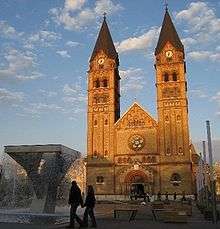
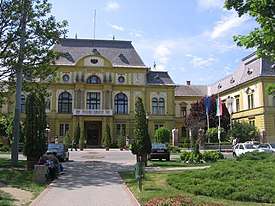
Nyíregyháza also has several museums and exhibitions, showing the city's rich cultural heritage.
- Collection of the International Medallion Art and Small Sculpture Creative Community of Nyíregyháza-Sóstó – periodic exhibitions of works of contemporary artists
Politics
The current mayor of Nyíregyháza is Ferenc Kovács (Fidesz-KDNP).
The local Municipal Assembly, elected at the 2019 local government elections, is made up of 22 members (1 Mayor, 15 Individual constituencies MEPs and 6 Compensation List MEPs) divided into this political parties and alliances:[8]
| Party | Seats | Current Municipal Assembly | ||||||||||||||||
|---|---|---|---|---|---|---|---|---|---|---|---|---|---|---|---|---|---|---|
| Fidesz-KDNP | 13 | M | ||||||||||||||||
| Opposition coalition[lower-alpha 1] | 9 | |||||||||||||||||
List of mayors
List of City Mayors from 1990:
| Member | Party | Term of office | |
|---|---|---|---|
| Zoltán Mádi | Fidesz | 1990–1994 | |
| Lászlóné Csabai | MSZP | 1994–2010 | |
| Ferenc Kovács | Fidesz | 2010– | |
International relations
Twin towns — Sister cities
Nyíregyháza is twinned with :
Notable residents
- Márton Fucsovics - professional tennis player
- Miklós Kállay
- Gyula Krúdy
- György Mitró
- Gábor Nógrádi - author, screenwriter, playwright, essayist, publicist and poet
Broadcasting
Near Nyíregyháza, at 47°56′12.17″N 21°45′28.35″E, stands the oldest radio mast in Hungary. Built in 1925, it is a 115-metre (377 ft) tall guyed mast radiator, used for broadcasting on 1251 kHz (AM).
References and notes
- References
- KSH - Nyíregyháza, 2017
- Eurostat, 2016
- KSH - Nyíregyháza, 2011
- KSH - Nyíregyháza, 2011
- "Pinkas Hakehillot Hungary: Nyiregyhaza". www.jewishgen.org.
- Seemann, Uwe. "Information Portal to European Sites of Remembrance". www.memorialmuseums.org.
- Grand Rabbi Joseph Leifer of Nyíregyháza is buried in the cemetery. He was the son of the world-renowned Rabbi, Rabbi Mordachai of Nadvorna, and he settled in Nyíregyháza after World War I where he attracted a large following. His grave site is visited annually by thousands of Hasidim.
- "Városi közgyűlés tagjai 2019-2024 - Nyíregyháza (Szabolcs-Szatmár-Bereg megye)". valasztas.hu. Retrieved 2019-10-29.
- "Serwis informacyjny UM Rzeszów - Informacja o współpracy Rzeszowa z miastami partnerskimi". www.rzeszow.pl. Archived from the original on 2012-12-05. Retrieved 2010-02-02.
- "TABEL privind LOCALITÃŢILE ÎNFRĂŢITE cu localităţile din judeţul Satu Mare" (in Romanian). www.prefecturasatumare.ro. Archived from the original on 2011-06-11. Retrieved 2009-06-27.
- Офіційний сайт міста Івано-Франківська. mvk.if.ua (in Ukrainian). Retrieved 7 March 2010.
- "National Commission for Decentralised cooperation". Délégation pour l’Action Extérieure des Collectivités Territoriales (Ministère des Affaires étrangères) (in French). Archived from the original on 2013-10-08. Retrieved 2013-12-26.
- Notes
Further reading
External links

| Wikivoyage has a travel guide for Nyíregyháza. |
- Official site
- Sóstó Thermal Bath (in Hungarian)
- Sóstó Zoo
- Nyíregyházi Hírportál - hírek - news (in Hungarian)
- A portal site (in Hungarian)
- Index-Kelet - local news (in Hungarian)
- Happy Art Festival site in English
- Bronze Age settlement and a former Sarmatian burial ground discovered in Nyíregyháza
- Nyíregyháza at funiq.hu
- Restaurant, bar, pub, daily menu & gastro guide from Nyíregyháza (in Hungarian)
